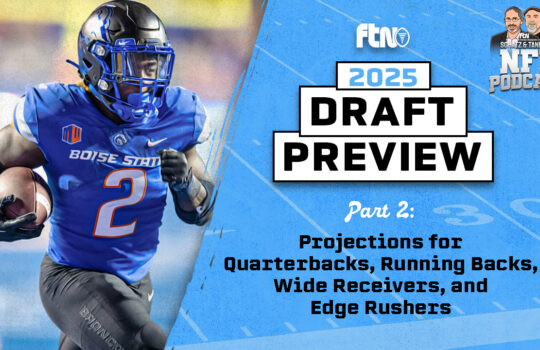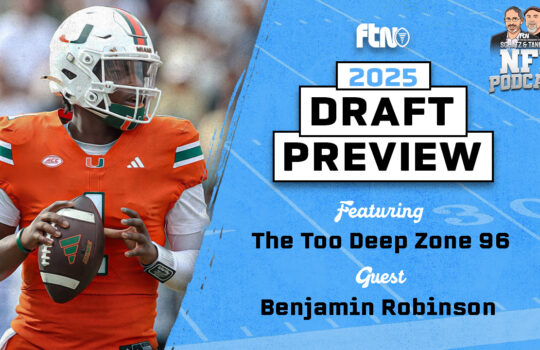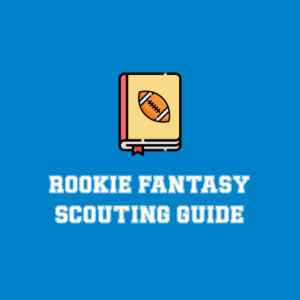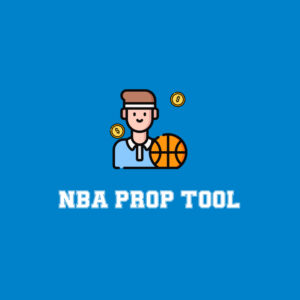
(Welcome to the FTN Fantasy NFL Coaching & Coordinator Series. All summer, our Adam Pfeifer will be looking at every team’s coaching staff through a fantasy football lens, to see what means what and how a fantasy manager can capitalize on it. Today: The Pittsburgh Steelers.)
Pittsburgh Steelers Head Coach: Mike Tomlin
Steelers head coach since 2007
16 years and zero losing seasons. No matter what, Mike Tomlin is going to win more games than he loses. Add 10 postseason appearances and two Super Bowl titles, and it’s no secret that Tomlin is one of the greatest head coaches in the history of football. Tomlin is the second-longest tenured coach in the NFL, as this will be his 17th season with the Steelers. Pittsburgh has been one of the most consistent teams over the last 15 years, and if their quarterback play didn’t fall off a cliff over the last few seasons, it’s entirely possible that Tomlin would have added a third Super Bowl ring to his collection. At the same time, if it wasn’t for Tomlin, this team likely wouldn’t have made the playoffs the last few years that they did. While he doesn’t call the plays on offense, we know that his teams have featured one running back very, very often, which has been extremely dependable for fantasy football purposes.
| Year | RB | Opportunity Share | Rank |
| 2014 | Le’Veon Bell | 77.30% | 3rd |
| 2015 | Le’Veon Bell | 82.70% | 1st |
| 2016 | Le’Veon Bell | 95.20% | 1st |
| 2017 | Le’Veon Bell | 89.30% | 1st |
| 2018 | James Conner | 83.10% | 3rd |
| 2021 | Najee Harris | 86.40% | 1st |
Offensive Coordinator: Matt Canada
Steelers OC since 2021
Canada has only been Pittsburgh’s offensive coordinator for two seasons, but many are surprised to see him return for a third season in 2023. The Steelers defense was unsurprisingly good last season, but the offense left plenty to be desired. Having a rookie quarterback certainly didn’t help, but Canada’s scheme has had many Steelers fans annoyed. Touchdowns were the issue last year, or lack thereof, as the Steelers scored touchdowns on just 51.9% of their red-zone trips in 2022, the ninth-lowest rate in the league. And despite averaging the most plays per drive in the NFL (6.5), Pittsburgh ranked just 23rd in points per drive (1.68).
The Run Game
Over the last few years, Ben Roethlisberger has had a huge say in what the offense would look like, and you knew that wasn’t going to change in the final season of his career. Roethlisberger and former offensive coordinator Todd Haley weren’t always on the same page, as he often wanted the pace to be different and to have more control over the offense.
So during Roethlisberger’s final NFL season, we saw glimpses of what Canada’s offense might look like, but certainly not everything. During his time as a coordinator at Maryland, Canada used a ton of pre-snap motion. In fact, the Terrapins were second in the entire nation in pre-snap motion, so it wasn’t surprising to see the Steelers lead the entire preseason in pre-snap motion during the 2021 preseason. However, the regular season wasn’t the same, as Pittsburgh ranked outside the top-20 in pre-snap motion.

With Roethlisberger gone, I expect Canada to have even more of an imprint on this offense, which means way more motion before the snap. It’s fair to say that Canada and Roethlisberger may not have meshed well if they were together for a longer time frame. Three huge elements of Canada’s offense are pre-snap motion, play-action passing and formations with the quarterback under center. During the Steelers’ first season without Roethlisberger, they ranked right around the middle of the pack in pre-snap motion at around 36%.
Canada especially loves to utilize jet motion when running the football, whether it’s with the running backs or wide receivers. Pittsburgh ran jet sweeps 10% of the time last year, easily the highest rate in the league, while a staple of their run game was inside zone with jet motion before the snap. Harris finished second among running backs in runs out of zone concepts last year with 181, while ranking fourth during his rookie season with 176. And according to FTN Data, the Steelers ranked fifth in the NFL in run plays off pre-snap motion (251), which made up about half of their total run plays.
The Passing Game
The season-long numbers for Pittsburgh’s passing game certainly don’t look pretty. Pittsburgh ranked last in passing touchdown rate (2.1%), 30th in yards per attempt (6.4) and 27th in yards per completion (10.1). Canada’s scheme is pretty predictable, and he and the Steelers have to do a better job of generating layups for sophomore signal-caller Kenny Pickett.
During his rookie season, 11.3% of Pickett’s targeted routes were go routes, the third-highest rate among qualified QBs, according to FTN Data. However, just 5.8% of his pass attempts were screens (29th), and he ranked dead last in slant route target rate (2.2%). And despite Pickett having the mobility to roll out of the pocket, the Steelers rarely called play-action. In fact, Pittsburgh used play-action just 19% of the time last season, which ranked 29th in football. Once Pickett took over in Week 4, his play-action dropback rate of 18.6% was the fifth-lowest rate among qualified quarterbacks. Pickett, who ranked fifth in the league in pass attempts from outside the pocket (74), should continue to throw on the run going forward, but let’s set it up with more play action, Pittsburgh.
 The Steelers ran a lot of bunch formations out of 11 personnel. According to FTN Data, the Steelers used bunch formations about 10% of the time, the eighth-highest rate in football, while their 108 plays out of bunch were the fifth-most. Pickett was pretty efficient when throwing out of bunch, ranking fifth in passing yards (290) and sixth in yards per pass attempt (8.3).
The Steelers ran a lot of bunch formations out of 11 personnel. According to FTN Data, the Steelers used bunch formations about 10% of the time, the eighth-highest rate in football, while their 108 plays out of bunch were the fifth-most. Pickett was pretty efficient when throwing out of bunch, ranking fifth in passing yards (290) and sixth in yards per pass attempt (8.3).
Canada used bunch formations to create traffic and havoc for opposing defenses in man coverage. Pickett was more comfortable out of the shotgun, so the Steelers primarily passed from the gun with him under center. Of his 389 total pass attempts last year, 349 came out of the shotgun formation (89.7%). Entering his second season, I really hope to see Pickett have more layups schemed for him by Canada. The Steelers heavily relied on perimeter routes from Diontae Johnson and George Pickens, which worked at times because both are fantastic wideouts.
However, the Steelers targeted the middle of the field just 20% of the time last year, a bottom-10 rate in football. And as we mentioned, there was essentially zero presence of a screen/quick game from this offense, which led to Pickett ranking dead last among qualified quarterbacks in yards after the catch per completion (4.4). And despite the predictable and often one-dimensional passing scheme, Pickett really shined down the stretch last year. From Weeks 11-18, Pickett ranked sixth among quarterbacks in PFF grade and fourth in big-time throw rate (6.3%). I just hope to see an uptick in play-action and quick-hitting layups from the Steelers this upcoming season.
| Quarterback | YAC/CMP | Rank |
| Kenny Pickett | 4.4 | 33rd |
| Josh Allen | 4.4 | 33rd |
| Geno Smith | 4.5 | 32nd |
| Jacoby Brissett | 4.6 | 31st |
| Dak Prescott | 4.6 | 31st |
Personnel
The Steelers continue to run a ton of 11 personnel (three wide receivers). Because Pittsburgh has had so many tremendous wide receivers over the years, it has made sense to play three wideouts very often. Pittsburgh has operated out of 11 personnel 75% of the time in two of the last three seasons, placing them inside the top-five during that stretch. The Steelers had been a spread offense during the final few seasons of Roethlisberger’s career, as they sported at least a 70% 11 personnel rate in each of the last four seasons. Last year, their 11 personnel rate dropped a bit to 69%, but it should remain a huge part of Canada’s offense.
We already discussed Pittsburgh’s usage of bunch formations, as they ran the fifth-most offensive plays from bunch. And while we talked about Pickett’s success throwing out of the formation, the Steelers also liked running the football out of bunch. Only the Giants and Packers ran the ball on more plays from bunch in 2022 (59).
Defensive Coordinator: Teryl Austin
Steelers defensive assistant and secondary coach 2019-2021, DC since 2022
2022 was Austin’s first season as the defensive coordinator in Pittsburgh, though he had been a defensive assistant and secondary coach from 2019-2021. Last year wasn’t Austin’s first stint as a defensive coordinator, however. Austin was the defensive coordinator of the Bengals in 2018 and the Lions from 2014-2017.
Detroit was a top-10 defense in 2014, allowing the second-fewest yards per game that season. Tomlin had been calling defensive plays for the Steelers for a while, but Austin called the defensive plays this past season. Pittsburgh’s end-of-season defensive stats were fine, but we have to remember that their unit fell apart with T.J. Watt sidelined. In the seven games Watt missed last year, the Steelers surrendered 25.3 points and about 390 total yards per game, while recording just eight total sacks. However, in the 10 games when Watt was active, Pittsburgh coughed up just 16.9 points and 100 fewer yards per contest.
Fantasy Football Takeaways
Sure, the production wasn’t great from Kenny Pickett last year. He ranked 33rd among signal-callers in fantasy points per dropback (0.35) and 30th in fantasy points per game (11.7). However, it also doesn’t tell the whole story. For starters, he legitimately played like a top-10 quarterback during the final seven weeks of the season, despite playing in a predictable passing attack. Pickett also had an absurdly low touchdown rate of 1.8%, which just isn’t going to happen again. Based on what he showed down the stretch, and the fact that the Steelers have good pass-catchers and an improving offensive line, it isn’t difficult to see a breakout sophomore season from Pickett.
He also provides value with his legs, averaging 4.2 rush attempts and nearly 20 rushing yards per game. And from the time of his debut (Week 4) on, Pickett ranked sixth among quarterbacks in carries from inside the five-yard line. There’s plenty to like here, and while it’ll be tough for him to crack QB1 territory, Pickett is a strong QB2 candidate in superflex leagues and a dynasty trade target.
No player in the NFL has more touches since 2021 than Najee Harris, who is flirting with a whopping 700 during that span. He hasn’t missed a game yet, but Harris has struggled with efficiency, ranking outside the top-50 in yards per touch this past season (4.0). The explosive plays haven’t been there either, as Harris recorded just seven runs of 15-plus yards on 272 carries last year. We also saw the usage in the passing game drop with the Steelers going from the statue Ben Roethlisberger to Kenny Pickett. Harris’s targets fell from 94 targets during his rookie year to 53 this past season.
Not only were there fewer checkdowns, but Harris also lost playing time on third downs, as Jaylen Warren played 52% of Pittsburgh’s third downs this past season with Harris around 40%. Tomlin has always leaned on one running back, but Warren, who had four explosive runs on just 77 carries, continues to vow for more opportunities. As of now, Harris is a mid-range RB2 for me.
Warren, meanwhile, played really well in a limited role last season, averaging 4.9 yards per carry and 3.08 yards after contact per rush on 77 carries. The Steelers were very comfortable playing Warren on third downs as mentioned before. In the passing game, Warren was reliable, averaging 6.5 yards per target. Though he lacks standalone upside, Warren would get all of the work if Harris, who has the most touches in football over the last two seasons, misses any time.
Diontae Johnson somehow failed to score a touchdown on 147 targets, but he’s still fantastic at creating separation and getting open. In fact, according to FTN Data, Johnson led the entire league in target share against man coverage (36%). And that ability to get open has led to Johnson ranking fifth in the NFL in targets since 2020, trailing only Davante Adams, Stefon Diggs, Justin Jefferson and Tyreek Hill.
Johnson’s 2022 campaign was truly unlucky, as despite scoring zero touchdowns, he still finished ninth in the league in end-zone targets (11), while seeing 29% of Pittsburgh’s red zone targets, the ninth-highest rate among wideouts. Johnson is somehow still being drafted as a WR3 and is a high-floor WR2 to me.
George Pickens’ rookie season was up and down, and he finished with just over 800 yards and four touchdowns on 52 catches. He was more productive with the rookie under center, as Pickett gave him more opportunities down the field. In 13 games alongside Pickett, Pickens averaged nearly two more receptions, 23 more receiving yards and 6.5 more PPR points per game. If you look at the 13 games with Pickett under center, Pickens was eighth among all wideouts in deep targets with 20. And over the course of the season, his 15.6 aDOT was the ninth-highest among qualified wide receivers.
Pickens also demonstrated tremendous contested-catch ability, hauling in 19-of-28 contested-catch opportunities (67.9%). And per PlayerProfiler, Pickens ranked 18th in fantasy points per target (1.96) and 15th in QB rating per target (108.0). You’d like to see him run more than just go routes, but he flashed tremendous upside last year.
Tight end Pat Freiermuth also struggled to find the end zone last year, scoring just twice. He still finished as TE7 in fantasy and continues to showcase strong efficiency. Freiermuth ranked seventh in yards per route run (1.68), ninth in yards after the catch (286) and 10th in aDOT (8.4). His 24% targets per route run mark was also the sixth-highest among qualified tight ends. Unless Pickens’ role drastically changes, Freiermuth will probably finish second on the team in targets again. He’s an obvious top-seven fantasy tight end.


















































 New York Jets
New York Jets  New England Patriots
New England Patriots  Miami Dolphins
Miami Dolphins  Buffalo Bills
Buffalo Bills  Pittsburgh Steelers
Pittsburgh Steelers  Cleveland Browns
Cleveland Browns  Cincinnati Bengals
Cincinnati Bengals  Baltimore Ravens
Baltimore Ravens  Tennessee Titans
Tennessee Titans  Jacksonville Jaguars
Jacksonville Jaguars  Indianapolis Colts
Indianapolis Colts  Houston Texans
Houston Texans  Las Vegas Raiders
Las Vegas Raiders  Los Angeles Chargers
Los Angeles Chargers  Kansas City Chiefs
Kansas City Chiefs  Denver Broncos
Denver Broncos  Washington Commanders
Washington Commanders  Philadelphia Eagles
Philadelphia Eagles  New York Giants
New York Giants  Dallas Cowboys
Dallas Cowboys  Minnesota Vikings
Minnesota Vikings  Green Bay Packers
Green Bay Packers  Detroit Lions
Detroit Lions  Chicago Bears
Chicago Bears  Tampa Bay Buccaneers
Tampa Bay Buccaneers  New Orleans Saints
New Orleans Saints  Carolina Panthers
Carolina Panthers  Atlanta Falcons
Atlanta Falcons  San Francisco 49ers
San Francisco 49ers  Seattle Seahawks
Seattle Seahawks  Los Angeles Rams
Los Angeles Rams  Arizona Cardinals
Arizona Cardinals 








 Boston Celtics
Boston Celtics  Brooklyn Nets
Brooklyn Nets  Philadelphia 76ers
Philadelphia 76ers  New York Knicks
New York Knicks  Toronto Raptors
Toronto Raptors  Chicago Bulls
Chicago Bulls  Detroit Pistons
Detroit Pistons  Milwaukee Bucks
Milwaukee Bucks  Cleveland Cavaliers
Cleveland Cavaliers  Indiana Pacers
Indiana Pacers  Orlando Magic
Orlando Magic  Atlanta Hawks
Atlanta Hawks  Charlotte Hornets
Charlotte Hornets  Miami Heat
Miami Heat  Washington Wizards
Washington Wizards  Denver Nuggets
Denver Nuggets  Minnesota Timberwolves
Minnesota Timberwolves  Oklahoma City Thunder
Oklahoma City Thunder  Portland Trail Blazers
Portland Trail Blazers  Utah Jazz
Utah Jazz  LA Clippers
LA Clippers  Golden State Warriors
Golden State Warriors  Los Angeles Lakers
Los Angeles Lakers  Phoenix Suns
Phoenix Suns  Sacramento Kings
Sacramento Kings  Dallas Mavericks
Dallas Mavericks  Houston Rockets
Houston Rockets  Memphis Grizzlies
Memphis Grizzlies  New Orleans Pelicans
New Orleans Pelicans  San Antonio Spurs
San Antonio Spurs 











